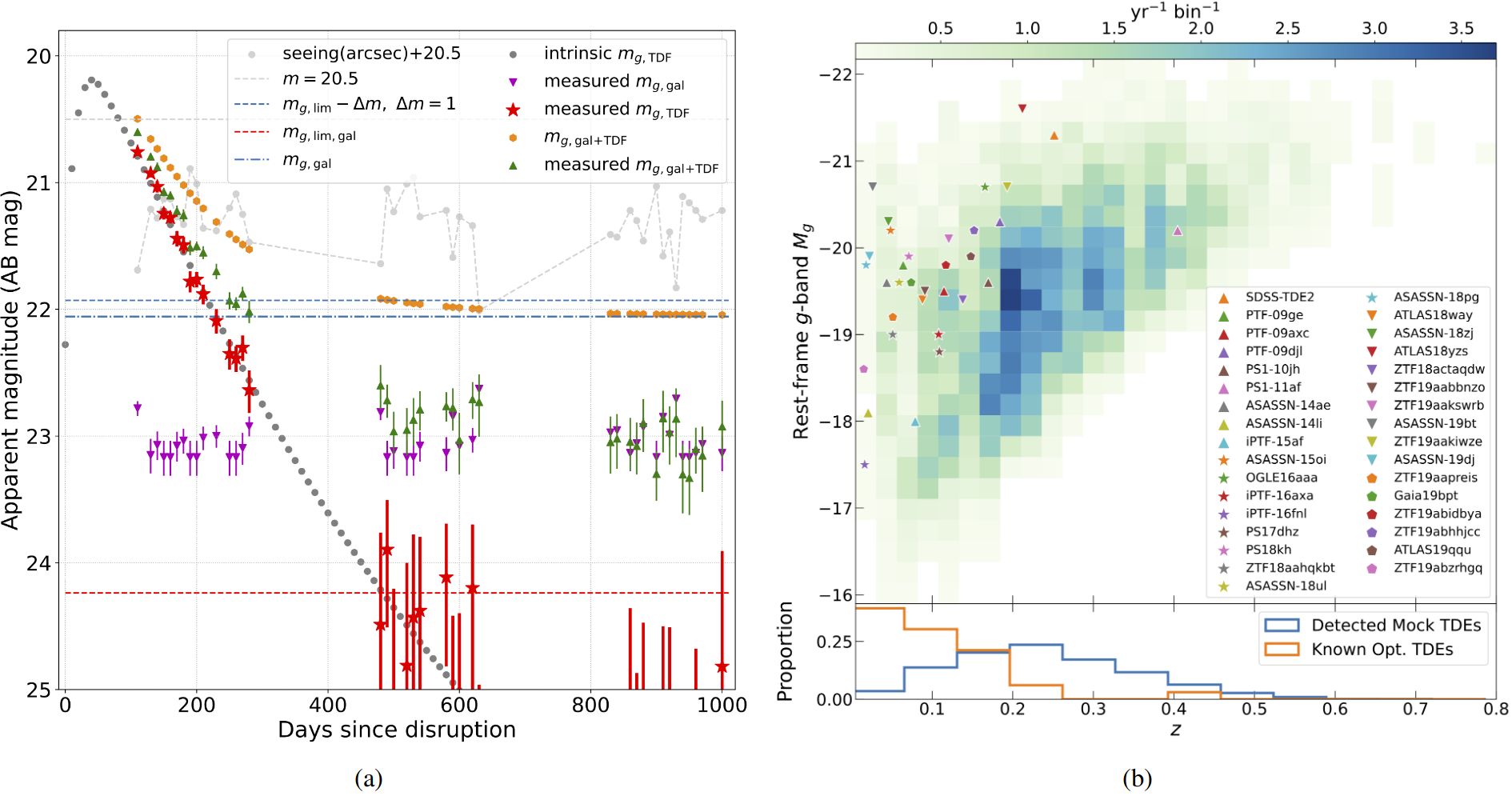The past decade has witnessed a groundbreaking development in transient research with the detection of an increasing number of Tidal Disruption Events (TDEs). These events occur at a much lower rate than supernovae, with an occurrence rate ranging from 10^(-4) to 10^(-5) per galaxy per year. This places TDEs in the category of rare celestial phenomena. Importantly, optical TDEs are now being identified in real-time, enabling the possibility of conducting timely multiwavelength follow-up observations. TDEs have generated widespread interest within the scientific community due to their unique and significant scientific value.
From an observational standpoint, the growing number of nuclear transients, occurring both in normal and active galaxies, has posed a fundamental question: how can these diverse transients, including TDEs, newly activated Active Galactic Nuclei (AGNs), sporadic gas accretion events, and others, be effectively classified into distinct categories of Supermassive Black Hole (SMBH) transient accretion events? WFST, working in synergy with other multiwavelength/messenger time-domain facilities expected to come online in the next decade, presents an unparalleled opportunity to address these complex questions and many others.
(1) Demography of Dormant SMBHs Revealed by Large TDE Samples
The Wide-Field Space Telescope (WFST) stands poised to excel beyond the capabilities of the Zwicky Transient Facility (ZTF) by capitalizing on several key advantages, including improved depth, the inclusion of the u-band, enhanced photometric accuracy, and superior spatial resolution in imaging. Of particular note is the utilization of the u-band, which corresponds closely to the peak wavelength of TDE Spectral Energy Distributions (SEDs). This unique feature sets WFST apart from other facilities expected to dominate TDE discovery and characterization in the northern hemisphere.
To assess WFST's potential for detecting TDEs, we conducted mock observations, meticulously considering site conditions, telescope parameters, and survey strategies. By adopting a more conservative approach that incorporates the u, g, r, and i bands, allowing for the comprehensive capture of SED information (with particular emphasis on the u-band), we anticipate the detection of 29 ± 6 TDEs in the CosmoDC2 field. This translates to a robust detection rate of 532 ± 100 TDEs per year within the scope of an 8000-square-degree wide-field survey.
Beyond expanding the sample size of TDEs, WFST is poised to make significant strides in extending the redshift range, potentially reaching up to z ∼ 0.8. This extension is based on our mock observations and promises to provide valuable insights into TDEs occurring at higher redshifts.

Figure 1, (a): The g-band light curves of a TDE at z = 0.253 as an example of our mock observations. (b) top: The peak absolute g-band magnitude (Mg) as function of redshift for TDEs detected in our mock observations. bottom: the histograms of TDE redshift in the mock and known sample.
(2) Hunting for IMBHs through TDEs
The scarcity of unambiguously identified Intermediate-Mass Black Holes (IMBHs) and the limited understanding of their formation mechanisms present a formidable challenge to astrophysicists. In a deep survey field spanning 300 square degrees, we anticipate the discovery of tens to possibly hundreds of Fast Blue Optical Transients (FBOTs) annually. It's important to note the significant uncertainty in the event rate. This positions WFST as one of the foremost facilities for conducting research related to FBOTs.
Fast TDEs, characterized by a rising time (trise) falling between that of FBOTs (∼ 3 days) and typical TDEs (∼ a month), represent promising candidates for the presence of IMBHs. This theoretical association between trise and Black Hole (BH) mass provides a potential avenue for IMBH detection. The deep field capabilities of WFST are well-suited for unveiling additional fast-rising optical TDE candidates. This opens up an exciting opportunity for the exploration of dormant IMBHs situated in the centers of dwarf galaxies.
(3) Other Opportunities
In the era marked by the Wide-Field Space Telescope (WFST) and the Large Synoptic Survey Telescope (LSST), the challenge in TDE research lies in effectively distinguishing TDEs from other transient events and efficiently coordinating limited follow-up observation resources for events with notable scientific significance. Regular surveys conducted at cadences ranging from days to weeks are suboptimal for detecting TDEs during their early rising phases. In stark contrast, the advantages offered by the planned deep high-cadence field of WFST are striking.
Our estimations indicate that the emission and color of approximately 10 TDEs will be measurable by WFST as early as 30 days before their peaks (in the rest frame). The alignment of WFST's observation timeline with that of the Einstein Probe [18] is particularly promising for TDE studies. Optical and X-ray campaigns have traditionally played a predominant role in TDE discovery. The joint analysis of WFST and Einstein Probe data holds the potential to yield an unparalleled TDE sample, complete with high-cadence light curves (or upper limits). This dataset will provide a robust foundation for deriving luminosity functions in both the optical and X-ray spectral bands.
In addition to classical TDEs, where a star plunges into the tidal radius of a supermassive black hole (SMBH), partial tidal disruptions at positions just beyond the tidal radius are also conceivable. WFST's exceptional capacity to detect weak optical emissions positions us to anticipate the discovery of a substantial number of partial TDEs. However, the success of this strategy hinges on our ability to distinguish them from other massive nuclear transients.
TDEs have demonstrated their efficacy in producing Infrared (IR) echoes, which serve as effective tools for tracing the (sub)parsec environments of SMBHs in normal galaxies—a region that is otherwise exceedingly challenging to investigate. WFST's capabilities will contribute to constructing a TDE sample with enhanced completeness, including the detection of numerous optically-weak TDEs. This will enable the analysis of dust and gas echoes, based on a virtually unbiased sample. The culmination of this effort will represent a significant step towards achieving a profound understanding of the parsec-scale environment of SMBHs in various types of galaxies. Ultimately, this understanding will facilitate the construction of a panoramic picture of SMBH activity.